Imagine a consumer product. It doesn’t matter the exact item you bring to mind. Whatever the product, it begins life with its manufacturer and ends it with its user – or consumer. The space in between those two endpoints is where things can get more complicated. Or not, if you opt for the direct to consumer (DTC) model.
Often, manufacturers or consumer packaged goods (CPG) brands exist only in the first phase of the customer journey. Their business model involves creating products and then relying on a distribution network to get them out to consumers.
That system of distribution often encompasses one or more third parties. It’s where wholesalers, distributors, and retailers of all shapes and sizes come in. If you were going to be unkind, you might describe those companies as ‘middle-men’.
That’s certainly how they’re characterized by proponents of a new way to do business. That new approach for manufacturers is known as direct to consumer, DTC, or D2C. The central idea is for producers of goods to cut out the ‘middle-men’ of wholesale and retail. These D2C companies sell their wares direct to consumers.

There’s a lot more to DTC than that, however, and you can learn all about it by reading on. In this ultimate guide you’ll discover all the following:
- What does direct to consumer mean, and how does it relates to traditional retailers, wholesale, and marketing.
- How and why the present trend toward DTC has developed.
- What benefits or challenges you may encounter if you adopt a direct to consumer (DTC) approach.
- How to give yourself the best chance of maximizing direct to consumer sales.
What is DTC?
First, what is direct to consumer (DTC) is a new way for manufacturers or CPG brands to do business. It’s a sales channel strategy that diverts away from the hassle of traditional distribution. Manufacturers no longer produce their goods and pass them to a distribution network. Instead, they take their wares direct to consumers.
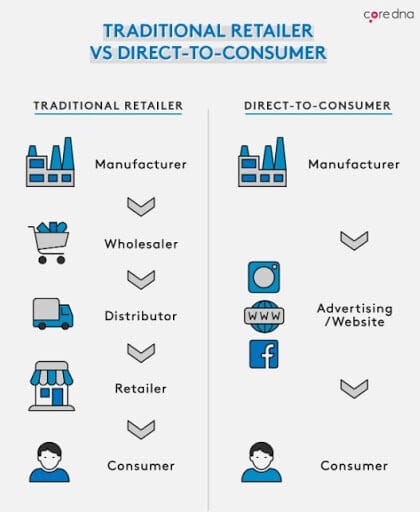
Image Source: Core DNA
The increasing ubiquity and efficiency of e-commerce platforms make D2C brands increasingly viable. Online retail stores and the software behind them have reshaped the consumer goods market. It’s no longer the case that manufacturers must rely on wholesalers or distributors. There are other options to reach the end customer. Thanks to e-commerce, there’s a lower barrier to entry for direct to consumer sales.
Brightpearl CEO, Derek O’Carroll, has followed the development of DTC closely. He believes that the shift towards DTC could have a profound impact on the retail sector:
“With the rise of consumer platforms, brands simply no longer need to rely solely on their distributors to stay in business. And many aren’t. Causing a tectonic change in the retail and services industry.”
The effects of a broader and sustained move toward DTC will be felt in many areas. Specifically, such a shift could reshape wholesale, retail, and – to an extent – marketing. What is DTC in marketing? We’ll find out later in the post.
Wholesale & Going Direct
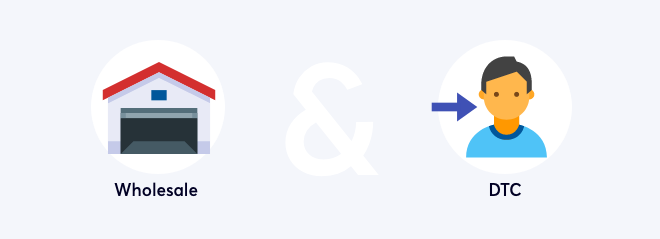
Wholesale is an integral part of the traditional retail supply chain. It’s a method by which manufactured goods often begin their journey end toward consumers. Selling product lines in bulk is the central premise of wholesaling. Either manufacturers themselves or specialist wholesalers sell large volumes of items to retailers. Those retailers then move the goods on to consumers singly or in smaller numbers, adding their own margins along the way.
Dedicated direct to consumer brands remove wholesale from the equation entirely. They interact directly with the end-users of their products. As such, brands used to selling in bulk must adapt to fulfilling a larger number of far smaller orders. This is a significant change to their operation playbook. Often, it means a manufacturer has to reshape an inventory management system.
Warehousing and logistics are very different if you handle a high volume of small orders. Each order must get picked and dispatched individually. That means devoting more staff hours or leveraging a better level of automation (more on that later). You may need to markup your products to maintain profitability, though a digitally native brand will still have less additional costs than one with physical stores.
The potential impact of a shift to DTC on wholesalers is even more vast. Those organizations rely on manufacturers utilizing traditional distribution for their existence. Their customer acquisition focuses on trade customers, not individuals. In a world where there are only direct to consumer sales, wholesalers have no place. We’re a way away from such an extreme circumstance. Firms in wholesale, though, will undoubtedly follow the DTC trend with wary interest.
Retailers & DTC
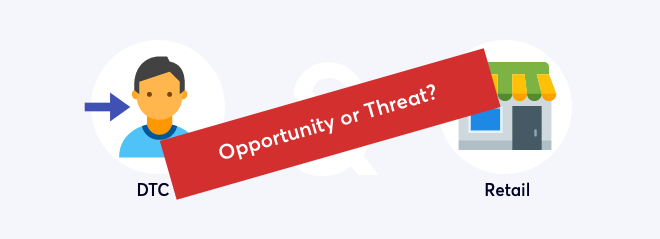
The wholesale part of the distribution network isn’t alone in feeling the effect of a trend toward DTC. Retailers, too, will get impacted if more brands seek direct to consumer sales. It’s not as clear cut, however, whether the impact will be positive or negative. As with many things, the reality is likely to fall somewhere between the two.
Retailers will naturally be concerned about more direct to consumer brands. Such brands (and their potentially cheaper pricing) provide direct competition to traditional brick-and-mortar and online stores. Direct to consumer companies present another option for potential customers, who already have a plethora of choices in the modern world.
It’s not all doom and gloom for existing retailers, however. Growth in the DTC channel could represent an opportunity – in a roundabout way. Manufacturers and CPG brands tend to be significant operations – think Nike or Gillette, rather than a startup. If – and when – they embark on a DTC approach, they put plenty of money behind it. That includes a high level of investment in their marketing strategy.
Such well-funded marketing campaigns raise brand awareness. They also generate consumer excitement for products. That’s good news for anyone selling those products, not only the manufacturer. Savvy retailers can capitalize on the efforts of CPG brands to boost their sales. Assuming the brands don’t adopt the DTC approach at the expense of all other distribution.
Retail outlets – in the physical or digital realm – will still get favored by some customers, too. Unlike direct to consumer brands, such retailers will carry lines from multiple manufacturers. They’re a literal one-stop-shop for all a customer’s desired items. After all, if you’re based in New York would you rather wait for something to ship from Germany, or head to a local store?
That doesn’t mean, however, that retailers won’t need to adapt and evolve. Facing more competition, a seller must mitigate the advantages of their new rivals. In the case of rivaling a DTC brand, that means trying to match the easy, convenient access to products. It’s not just millennials that desire fast and frictionless experiences – it’s all modern consumers. There’s no reason why they’d object to buying from a multi-brand retailer if that firm offers such an experience.
DTC, Marketing & Social Media
There’s more to adopting a direct to consumer marketing strategy than merely changing your method of distribution. Direct to consumer brands like Allbirds, Everland, and Bonobos take end-to-end control of the customer journey.
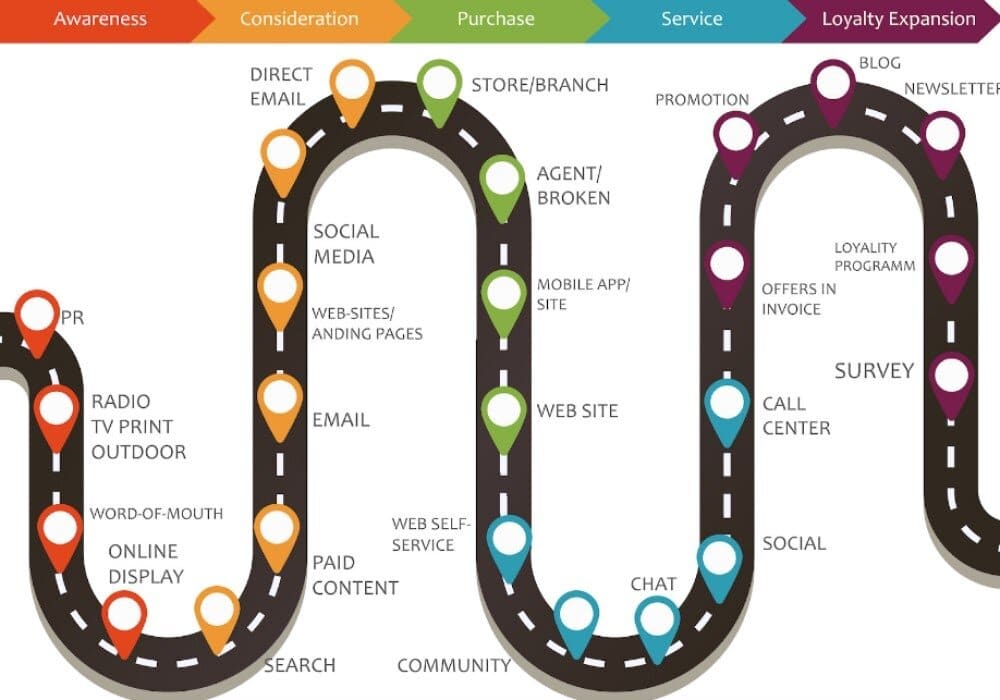
Image Source: Copper CRM
The above represents an example of a typical customer journey. When a brand adopts traditional distribution, they give up control of much of the journey. At the very least, the purchase and service steps get outsourced to retailers. Often, consideration and loyalty expansion are out of a manufacturer’s hands, too.
Brands that adopt a DTC approach take back more significant control over marketing. That’s as well as handling more of their efforts to raise brand awareness. Many successful DTC brands lean heavily on content and social media marketing. Intelligent, forward-thinking use of those marketing channels is invaluable. It helps to build a community of customers.
Razor company, Harry’s, is a prime example. They’ve recently broken into the ultra-competitive shaving market with a DTC approach. A vital element in making that approach work has been the firm’s smart marketing – that’s social media, email marketing, influencer campaigns, the whole works. Their whole brand ethos is about telling a story. That story is of their company and customers coming together to combat a broken industry.

Image Source: Harry’s
The primary drive behind the brand’s marketing is fairness. They present the idea to consumers that it’s unjust that they must spend so much on high-quality razors. Harry’s, therefore, gets to adopt the role of the consumer champion. That’s alongside providing the solution to the problem of overpriced shaving equipment. That’s the kind of modern, innovative marketing that DTC brands can implement.

What are DTC Brands?
As we mentioned above, DTC brands are those that maintain as much control as possible over the customer journey. With full access to customer data, they can learn to understand their users’ needs in order to provide relevant, convenient solutions and personalized experiences.
DTC brands also find ways to optimize their exposure, and differentiate themselves from their competitors. They aim to build a community of loyal supporters through content and social media marketing, and often form partnerships with other DTC brands to capture a mutual audience.
These brands may experiment with product diversification by selling complementary items, such as the brand Burrow, which began with modular couches but has branched out into additional homeware. Selling direct to consumers makes it easier to test out new products.
Some more traditional brands are also jumping on the DTC bandwagon, either acquiring existing DTC companies or setting up their own DTC offshoot. For instance, Gillette now has an online storefront called Gillette On Demand (almost certainly a response to the likes of Harry’s).
The Trend Towards DTC

So far, so theoretical. We’ve looked at what DTC is, and how it differs from the traditional approach to distribution. We’ve also covered how a shift toward direct-to-consumer businesses may impact existing distribution networks. What we must now turn to is an analysis of the present trend. Let’s drill down into the extent of the move toward DTC, and what’s driving it. Before looking at whether it’s going to be a permanent or transitory shift.
A Global Shift?
It’s undeniable that there’s been a significant shift toward DTC in recent years. There’s evidence of the increasing popularity of the DTCstrategy wherever you look. Direct to consumer sales are becoming more favored not only by brands but also by consumers.
A recent survey discovered that many consumers favor interacting directly with brands. It reported that 59% of those surveyed preferred to research products on a brand website.
What’s more, the report found 55% would rather buy direct from manufacturers. That’s as opposed to purchasing from a multi-brand retailer such as Walmart. The same survey, too, reflected the aforementioned importance of social media. According to the research, social media ads were the major prompt to visit a brand’s website.
There’s little suggestion, then, that the trend toward DTC is going to slow. In fact, the desire for direct to consumer sales from consumers is accelerating. A 2018 report delivered plenty of evidence to that end. It revealed that 81% of Americans claimed they’d make at least one DTC purchase in the next five years. More striking still, the study found 1/3 of Americans would make 40% of purchases from DTC brands.
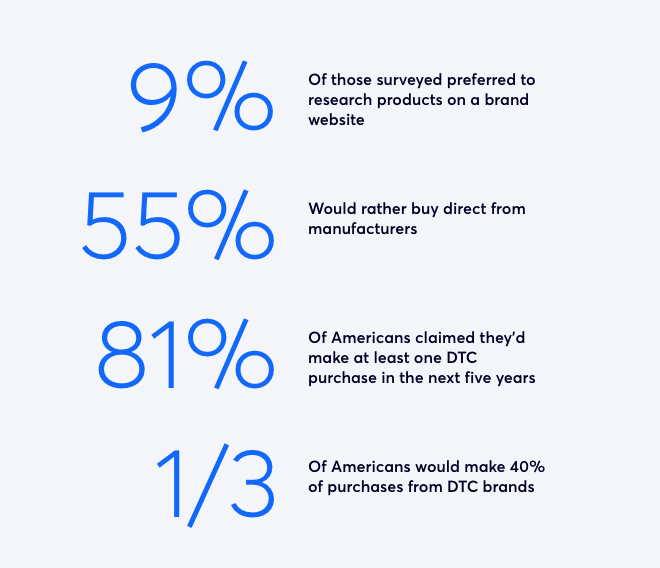
From the manufacturers’ perspective, the case of Nike is illuminating. Looking at that single global brand proves the popularity and potential of DTC. The renowned manufacturer has expanded far more into the DTC channel in recent years.
A Market Realist report shows that Nike’s DTC channel accounted for 24% of the firm’s revenue in 2016. That’s a significant proportion and is also up notably from 17% in 2013. There’s no sign, either, of Nike’s drive toward direct to consumer sales slowing. The projection below ably demonstrates that:
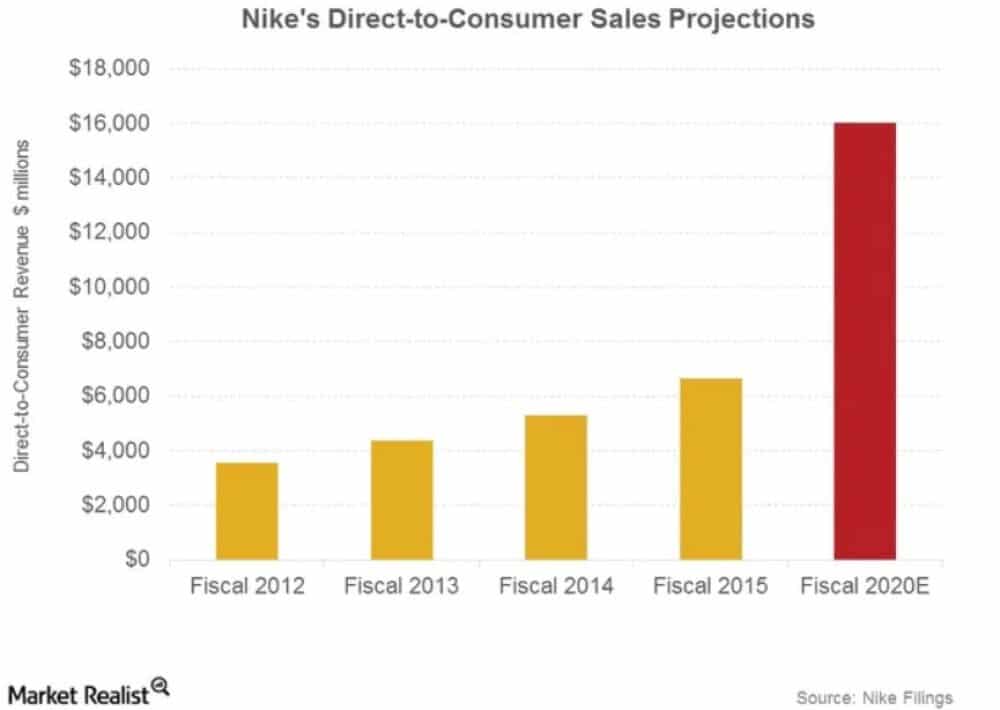
Image Source: Market Realist
To put that graph into context, it predicts that Nike’s DTC revenue may reach $16 billion this year. Even for a global goliath like Nike, that’s a vast amount of money.
Nike isn’t alone, either. There’s a definitive, worldwide shift by brands toward the direct to consumer model. 22% of US brands recently reported plans to launch DTC e-commerce within 12 months. That’s on top of the 71% of firms which had already done so. In the US and outside, companies that have already adopted DTC have seen striking success.
Notable DTC Success Stories
The move toward a direct to consumer approach isn’t brand-new. Some observers have watched the shift in the retail sector with interest for many years. The trend is accelerating, however, in no small part due to the success of some early adopters. The following are a few examples of newer DTC brands that have already made a splash. It’s a little wonder that other companies are now looking to follow their lead.
Finlay London

Finlay London is a premier eyewear brand that was initially founded in 2012. In its early years the company traded via the wholesale channel, before switching up their consumer model and transitioning to DTC in 2017. It was a notable shift, too, as the firm was previously 80% wholesale based. By leveraging the correct logistics solution from Brightpearl, Finlay London’s move to direct to consumer sales was a massive success.
The brand enjoyed 100% revenue growth in 2017. They also opened up a significant US market, primarily thanks to the new DTC channel. The story of Finlay London is one of how DTC and the right software can take an already successful brand to another level.
Warby Parker

Image source: Warby Parker
Warby Parker is another glasses and eyewear brand. Founded in 2010, it was one of the earlier examples of a disruptive DTC manufacturer. By targeting direct to consumer sales, the brand carved off a big slice of their industry. In early 2018, the company got valued at a cool $1.75 billion.
One of the principal reasons for Warby Parker’s popularity is the personalization the brand offers. Visitors to the website get invited to take a quiz to find frames that will suit them. They can then even get five sets sent to them to try on for free. That’s the kind of innovation in marketing and customer experience that’s possible with a direct to consumer marketing strategy.
Me Undies
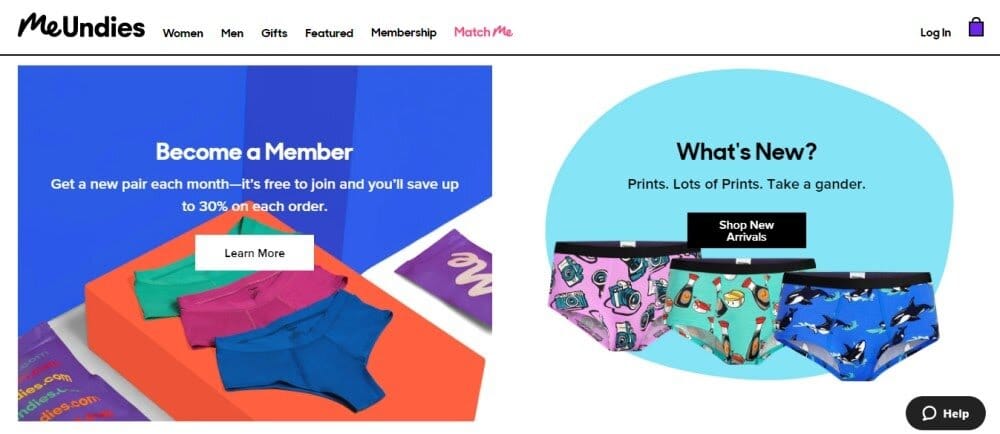
Image Source: Me Undies
The clothing niche is one of the most competitive around. Despite that, Me Undies have carved out a significant place within it thanks to their DTC strategy. Established in 2011, the company ended 2019 with more than $75 billion in revenue.
It was a blend of fun marketing (including lots of influencer campaigns) and a subscription-based model that worked so well for Me Undies. Their risqué advertising couldn’t help but capture the attention of new customers. Providing items via a monthly subscription, meanwhile, turned buying underwear into an experience.
What’s more, this version of direct to consumer sales also helped the brand test out new designs. They could add new patterns and prints that went down well with subscribers to the main online store. They could, on the other hand, abandon those that were less popular. That’s all without having first to produce them in higher numbers.
Casper

Image Source: Casper
Buying a mattress is something that most people don’t give a second thought. At least not until they have to do so – which only happens once in a blue moon. When that time comes around, replacing a mattress can be awkward and expensive. That’s the problem that the DTC brand, Casper, realized it could solve. The company has made a real impact by selling mattresses direct to consumers online.
Everything about the firm’s operation is customer-centric. Casper brands itself to ‘deliver on sleep and service’. To do so, the company offers high-quality products with lengthy guarantees. They then twin those with free shipping and returns and a 100-night risk-free trial. Thus, the brand has built a reputation for excellence in its niche.
Is DTC Here to Stay?

The DTC success stories detailed above are merely the tip of the iceberg. The trend towards a direct to consumer approach has been far from glacial. It’s been more of an avalanche. Newer brands such as Warby Parker use the DTC strategy to break into established markets. Large companies such as Nike, meanwhile, are also moving operations in a DTC direction.
Will this move toward direct to consumer sales last, however? That’s a crucial question for any brand considering a switch to the sales channel strategy. You can’t predict the future with 100% accuracy. Some changes, though, make too much sense to be anything less than permanent.
The underlying reason for DTC’s popularity is that it answers the desires of modern consumers. Today’s customers want personalization, convenience, and affordability. Those are all made a reality by the direct to consumer model. All that held manufacturers back was that they didn’t have the capability to cut out the middle-man. The rise of e-commerce platforms and related software has removed that barrier.
Ask an e-commerce or marketing expert, and they’ll tell you the primacy of customer experience. Meeting consumer needs and offering the service they want is vital to modern brands. So much so that customer experience may soon be the most important differentiator. More so than product or price. DTC directly supports improved customer experience. The trend toward the model, therefore, isn’t likely to slow any time soon.
Benefits & Challenges of DTC

Even if you didn’t before, you should now know how significant the trend toward DTC is to modern brands. It’s something you need to think about if you’re in the manufacturing or CPG niches. Let’s look at some of the principal benefits and challenges of a DTC strategy. They should help you judge whether direct to consumer is an avenue you need to explore.
Benefits
Recent Brightpearl research into the DTC trend revealed some fascinating insights. Amongst them were the principal reasons given by firms as to why they may consider the approach. The following graph shows some of the responses, from both sides of the Atlantic:
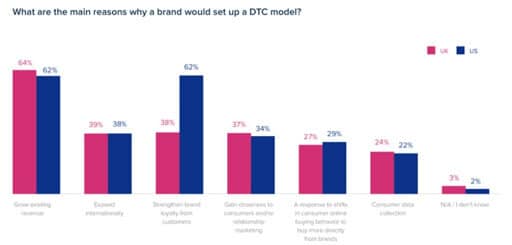
Potential benefits of a direct to consumer model, then, are varied. Some will be more pertinent to certain brands than others. Let’s look at five of the most notable.
Regaining Your Customer Data
You’ll have heard of the Stone Age, the Bronze Age, and the Iron Age. They’re the names given to periods in history, due to the pre-eminent technology of the era. Following the same pattern, the modern world really ought to be known as the Information Age. Never has it been truer that knowledge is power.
Today’s individuals and organizations generate more data than ever. Collecting and harnessing it is vital to success in many business processes. When brands operate via a wholesale model, they lose a crucial source of data. They don’t have ready access to the data provided by end-users. It’s the retailers that get all that juicy consumer information.
With a DTC approach, a brand regains its customer data. Consumer demand, e-commerce trends, demographics, and more are once again accessible. There are, therefore, new avenues for analytics and business intelligence. Brands can use the data on end-users to better inform marketing, sales, and other areas.

Greater Control Over Customer Experience
We’ve already touched on customer experience and its importance. With traditional distribution, there’s no direct interaction between manufacturers and consumers. As such, as the manufacturer, you have no control over the customer experience. That all changes in the case of direct to consumer sales.
All customer touchpoints are now in the remit of your brand. You produce your wares as you always did. Now, you also market the brand, advertise products, handle sales, and deal with post-sale. It’s in your power to maintain standards throughout the customer journey.

Building Stronger Customer Relationships
Controlling the entire customer journey has a further advantage. It means you can build more robust relationships with consumers. The most lasting interactions of anyone who buys from a retailer are those they have with the vendor. They’ll remember the service they got in-store or online. They may think favorably of the manufacturer if the product is of a high standard. That’s a secondary consideration at best, however.
Direct to consumer brands are part of every interaction with a customer. By delivering exceptional customer experience, you can build genuine relationships. That’s what leads to customer retention and high customer lifetime value (CLV). It’s also why many DTC brands do work hard to build a community amongst their customers.
New Products & Markets
The first step of any new product rollout is always research. No company will take a new line to market without testing its potential with a target audience. The DTC model maintains a direct line of communication between brands and end-users. Researching new products, therefore, is often far more straightforward.
Rather than paying for expensive research, brands can reach out to their customers. We’ve already seen how Me Undies bundles this kind of outreach into their subscription model. Crucial insights into consumer attitudes to new products are available in a fraction of the time.
Flexibility & Agility
The commercial world is far from static. Things can change in the comparative blink of an eye. Take, for example, the Coronavirus pandemic of 2020. The entire world got turned on its head in a matter of weeks. Such an unforeseen event has numerous commercial implications. Brands of all types must respond as quickly and effectively as possible.
With a DTC model, more agile responses are possible. The mode of distribution is more straightforward. You’re in charge of everything yourself. You aren’t reliant on any third parties or middle-men. That makes it easier to adapt and evolve at short notice.

Challenges
There’s little that’s black and white in the commercial world. Most businesses exist in an environment that’s decorated in shades of gray. Every decision you make will have drawbacks as well as advantages. That’s as true of choosing a DTC approach as of anything else. There are significant challenges associated with the transition to direct to consumer sales. The following trio are amongst the most crucial to consider.
Handling Operations Beyond the Buy Button
There’s a lot more to e-commerce than meets the eye. Manufacturers need to recognize that, before transitioning to DTC. There are, for instance, a vast number of operations that come ‘beyond the buy button’. These are critical processes that occur after the point of purchase. Too often, they get neglected by traditional and DTC e-commerce websites alike.
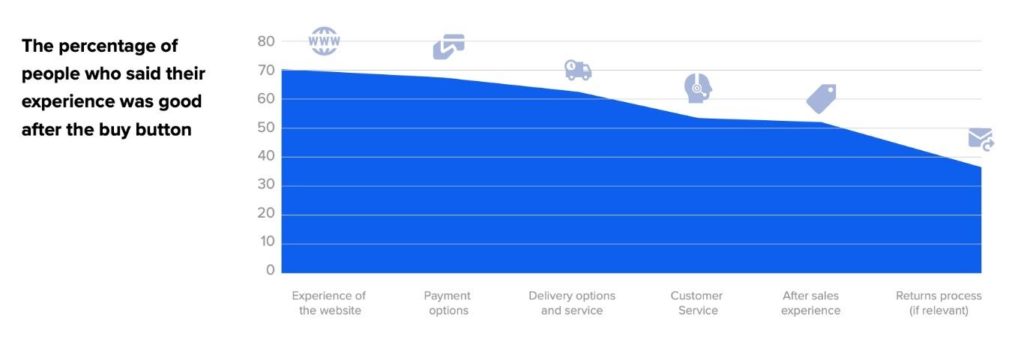
Image Source: Eastside Co
Examples of critical operations that come beyond the buy button are numerous. Some of the most vital include order fulfillment, shipping, and accounting. What’s more, those processes must get supported by others. They include equally critical operations like inventory management, warehousing, and logistics. Grasping the importance of and succeeding in these areas is a challenge for any brand new to the DTC realm.
Breakdown of Retailer Relationships
One of the principal benefits of DTC can also be one of its greatest challenges. That is that it reduces the involvement of wholesalers, distributors, and retailers. When implementing a direct to consumer approach, you’ll rely less on those third parties. You often won’t want to move away from them entirely, however.
The challenge, therefore, is to avoid a breakdown in your business relationships. You need to keep cordial and mutually beneficial relations with retailers. That’s not easy when you’re actively seeking to sell to their target audience. Whether you’re able to do it is a vital consideration when deciding if DTC is for you.
Lack of Tech & Customer-Facing Knowhow
Part of the reason you will want to keep working with – at least – some retailers is straightforward. Put simply, they’re good at selling to consumers; it’s what they do.
Retailers have the customer-facing experience that your brand may not. They also have the systems and tech in place to handle B2C (business to consumer) sales. If you’ve never sold direct to consumers before, you’ll have neither of those things. Accruing and developing them, while turning a profit, is another challenge of adopting a DTC approach.

Walking the Tightrope of DTC & Wholesale

What do those different benefits and challenges tell us? In short, they reveal that transitioning to a DTC approach is no trivial undertaking. If you take the plunge, you’ll need to respond to a new set of issues. You can’t get the unique advantages of the model without doing so. What’s often the best way to go, therefore, is to mingle wholesale and DTC.
Keeping Your Balance
A recent report found that 48% of manufacturers were planning to build DTC channels. That doesn’t mean they’re going to abandon traditional wholesale distribution. Instead, it means they want to add DTC channels to their existing models. Approaching DTC in this manner makes perfect sense.
If you do take this route, you need to balance two styles and speeds of order fulfillment. Your existing wholesale orders will remain larger but occasional. Alongside these, you’ll also start handling a higher volume of far smaller orders. Every part of your business, therefore, will face new operational demands.
Leveraging Automation & Tech
It’s those departments beyond the buy button that will face the most profoundly different requirements. Inventory management, shipping, logistics, and accounting are prominent examples. One of the best ways to ensure these departments are up to the challenge is by exploring automation.
Some of the best retail operations platforms automate workflows in all those areas. What’s more, if you do leverage a unified solution, your processes get streamlined. The different arms of your organization will always pull in the same direction. That’s invaluable to any brand embarking on direct to consumer sales for the first time.

Actionable Tips for Implementing a DTC Channel
We’ve delved deep into the subject of DTC. By now, you should be an expert in the sales channel strategy and its strengths and issues. To end this ultimate guide, let’s get a bit more practical. The following are some brief and straightforward tips. They should help you if you do wish to explore the DTC approach.
Keep Things Simple & Customer-Centric
When you get down to it, the ‘C’ of DTC is the essential element. Whether you’re starting a new brand or adding a DTC channel to your operation, you must take a consumer-first view. Make sure what you’re offering genuinely appeals to the customers you want to win from retailers.
Often, the best way to achieve a customer-centric approach is by keeping things simple. Some of the most successful DTC brands implemented a straightforward plan. Take Harry’s razors and Dollar Shave Club, for example. Both brands made a splash in the shaving market by taking a standard item and making it more inexpensive. It’s that kind of simplicity that will help you to make DTC work.
Integrate Content & Social Media Marketing
When you’re serving consumers directly, building customer relationships is crucial. If you can create a community of loyal customers – or even brand advocates – you’re well on the way to success. Intelligent use of content and social media marketing is invaluable in this regard.
Create an informative and entertaining blog. That will help you connect more closely with your target audience. Share your posts and other insights on social media, and you’ll keep them engaged. Glossier is an ideal example of a DTC brand that’s succeeded in this area.
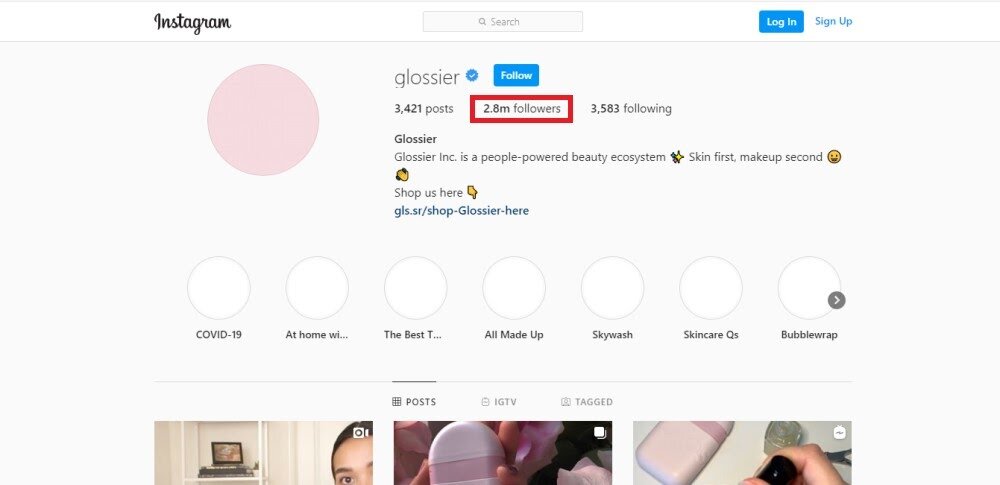
Image Source: Instagram
brand. The company uses social media as well as any other, too, with a gargantuan 2.8m followers on Instagram alone.
Build Trust With Returns Policy & Social Proof
Your business might have been around for decades. You might have an established network of distributors and retailers. If you’re transitioning to DTC for the first time, however, you still need to build trust with consumers. Customers might have purchased your products before. They’ve never bought from you before, though.
That means you need to adopt some practices more associated with younger brands. A customer-friendly returns policy is an ideal option. Making it easy to return unwanted items, free of charge, will win over a new audience. We’ve already talked about how a similar policy helps add to the success of Casper in the mattress industry.
Social proof is another avenue to explore for building trust. Consumers are more likely to buy from you if you can share positive reviews. High-profile endorsements from celebs or influencers are even better.

Take Advantage of Your Control Over the Customer Journey
One of the principal benefits of a DTC approach is that you get control over the customer journey. It’s your brand that’s involved in every customer touchpoint. You need to take advantage of that higher level of power to make your DTC channel a success.
Now that you’re managing sales and post-sale processes, make sure to get them right. Implement the best logistics solutions to ensure you nail your order fulfillment. Give customer support the attention it deserves, too. That way, your new customers don’t feel neglected. As a result, you can garner morebrand loyalty and boost your CLV.
Consider Third-Party Fulfillment Assistance
If you’re not used to selling direct to consumers, the fulfillment demands may take you by surprise. There’s often a radical difference from the requirements of selling wholesale. Reshaping an entire warehouse or inventory management system may not be viable.
Instead, you could seek help from third-party logistics (3PL) or fulfillment companies. Amazon is a prime example. Many brands choose to find direct to consumer sales via the Amazon Marketplace. There are other 3PL options, too. Many may integrate seamlessly with your existing logistics and sales platforms.
Conclusion
DTC is an important avenue to explore if you want your brand to stay in step with the modern world. Consumer demands for frictionless experiences have fueled a significant trend toward the model. The rise of e-commerce, meanwhile, has made direct to consumer sales more viable for a more extensive array of firms.
There’s more to the direct to consumer (DTC) sales channel strategy than meets the eye. It’s an approach with the potential to disrupt the entire retail sector. You must understand DTC inside out before you can know for sure if it’s the right way to go for your business. Hopefully, this comprehensive guide has provided all the information you need.
